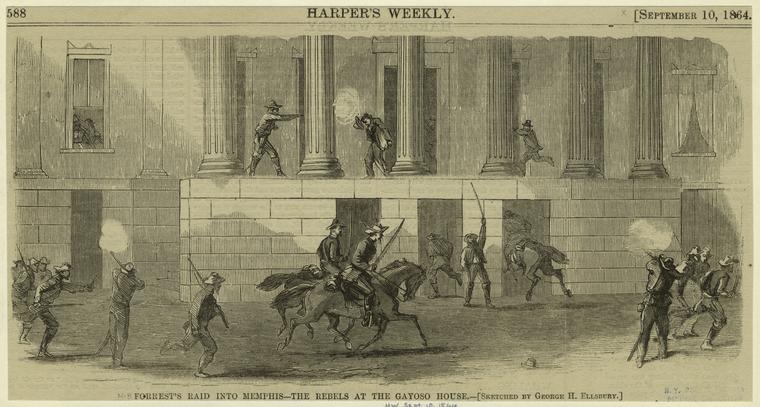 The Second Battle of Memphis was a battle of the American Civil War occurring on August 21, 1864, in Shelby
The Second Battle of Memphis was a battle of the American Civil War occurring on August 21, 1864, in Shelby  County, Tennessee. At 4:00 a.m. on August 21, 1864, Maj. Gen. Nathan Bedford Forrest
County, Tennessee. At 4:00 a.m. on August 21, 1864, Maj. Gen. Nathan Bedford Forrest 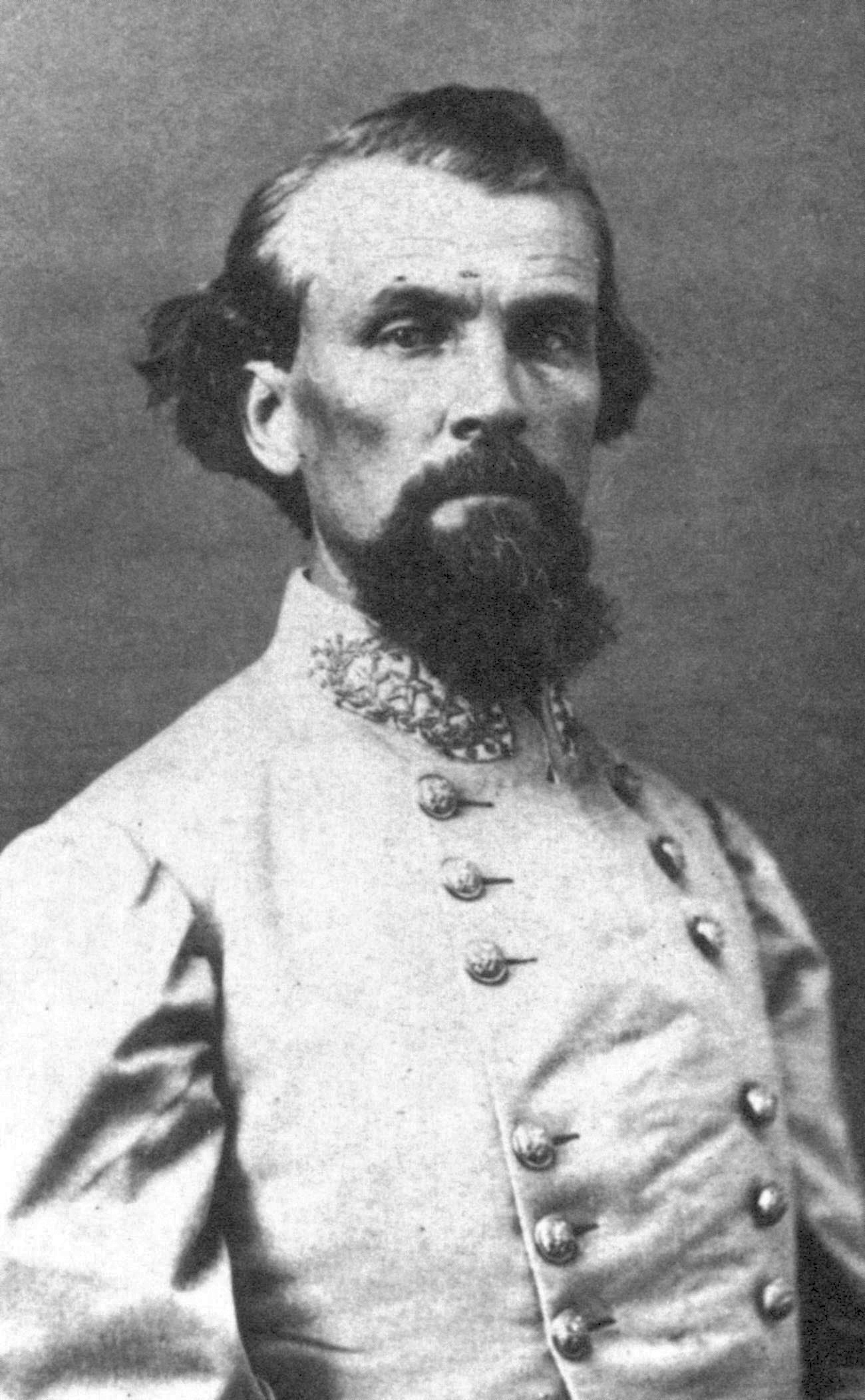 made a daring raid on Union-held Memphis, Tennessee, but it was not an attempt to capture the city, which was occupied by 6,000 Federal troops.
made a daring raid on Union-held Memphis, Tennessee, but it was not an attempt to capture the city, which was occupied by 6,000 Federal troops. The raid had three objectives: to capture three Union generals posted there; to release Southern prisoners from
The raid had three objectives: to capture three Union generals posted there; to release Southern prisoners from 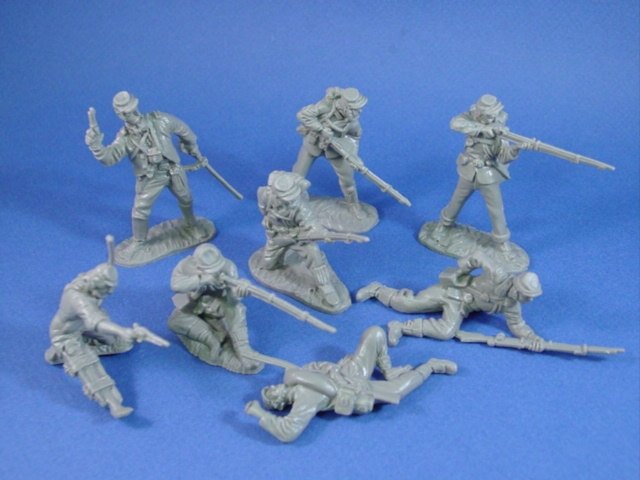 Irving Block Prison; and to cause the recall of Union forces from Northern Mississippi. Striking northwestward for
Irving Block Prison; and to cause the recall of Union forces from Northern Mississippi. Striking northwestward for  Memphis with 2,000 cavalry, Forrest lost about a quarter of his strength because of exhausted horses. Surprise
Memphis with 2,000 cavalry, Forrest lost about a quarter of his strength because of exhausted horses. Surprise was essential. Taking advantage of a thick dawn fog and claiming to be a Union patrol returning with prisoners, the
was essential. Taking advantage of a thick dawn fog and claiming to be a Union patrol returning with prisoners, the Confederates eliminated the sentries.above Mannie Gentile
Confederates eliminated the sentries.above Mannie Gentile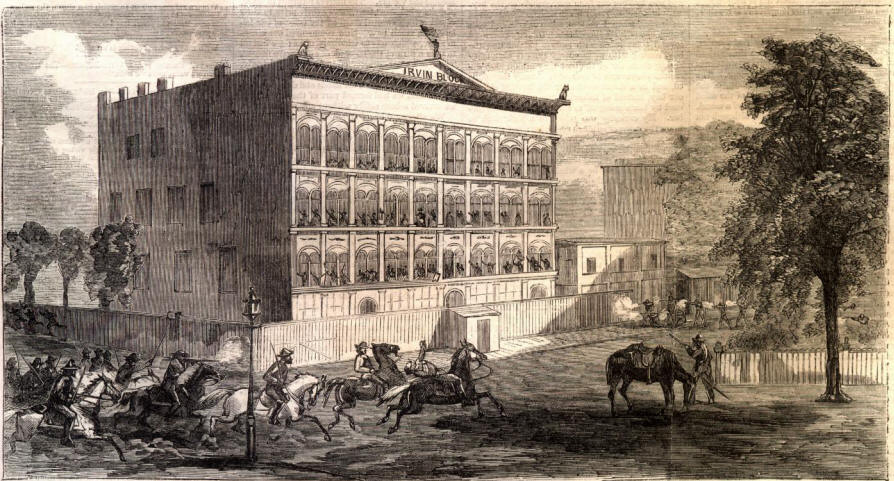
Galloping through the streets and exchanging shots with other Union troops, the raiders split to pursue separate missions. One union general was not at his quarters. Another, General Cadwallader C. Washburn escaped to Fort Pickering dressed in his night-shirt.
missions. One union general was not at his quarters. Another, General Cadwallader C. Washburn escaped to Fort Pickering dressed in his night-shirt.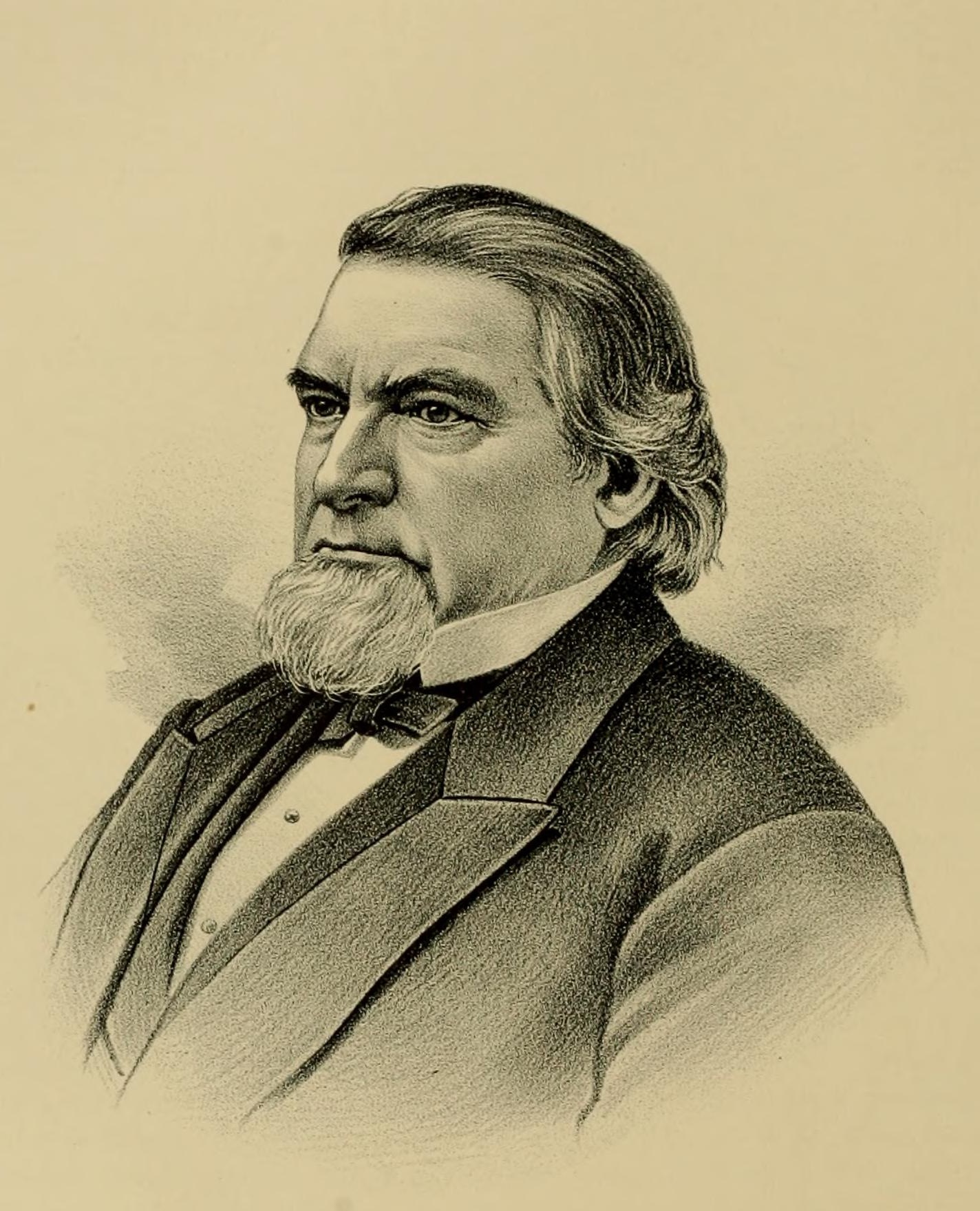 Forrest took Washburn's uniform, but later returned it under a flag of truce.According to Memphis legend, Confederate cavalrymen rode into
Forrest took Washburn's uniform, but later returned it under a flag of truce.According to Memphis legend, Confederate cavalrymen rode into
 the lobby of the luxurious
the lobby of the luxurious  Gayoso House Hotel seeking the Yankee officers. A street in Memphis is named "General Washburn's Escape
Gayoso House Hotel seeking the Yankee officers. A street in Memphis is named "General Washburn's Escape 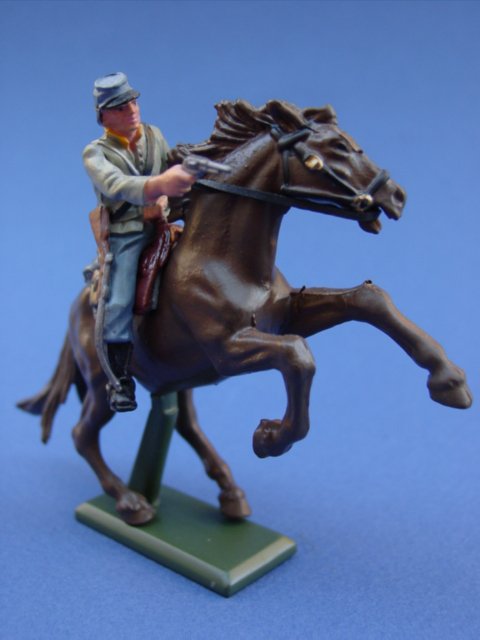 Alley" in commemoration of the ordeal.The attack on Irving Block Prison also failed when Union troops stalled the main body at the State
Alley" in commemoration of the ordeal.The attack on Irving Block Prison also failed when Union troops stalled the main body at the State  Female College. After two hours, Forrest decided to withdraw, cutting telegraph wires, taking 500 prisoners and large quantities of supplies, including many horses.
Female College. After two hours, Forrest decided to withdraw, cutting telegraph wires, taking 500 prisoners and large quantities of supplies, including many horses.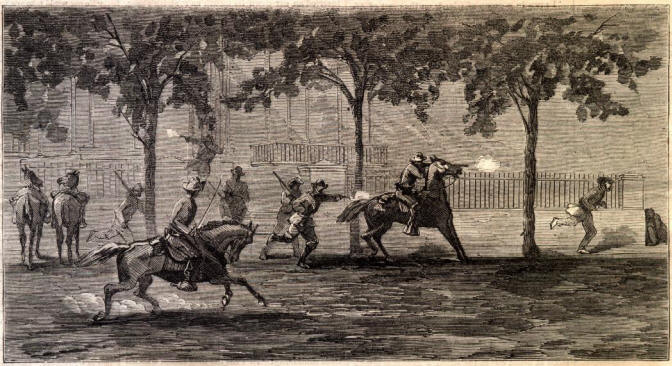
Although Forrest failed in Memphis, his raid influenced Union forces to return there, from northern Mississippi, and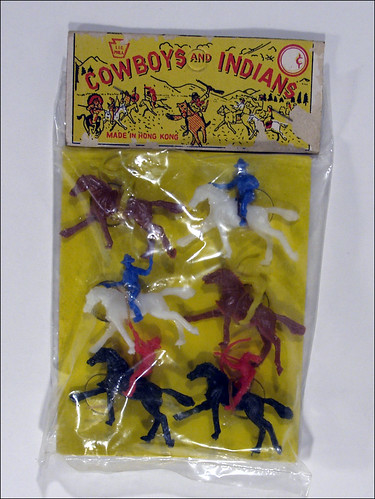 provide protection. Union General Hurlbut was quoted afterward as saying, "There it goes again! They superseded me with Washburn
provide protection. Union General Hurlbut was quoted afterward as saying, "There it goes again! They superseded me with Washburn  because I could not keep Forrest out of West Tennessee, and Washburn cannot keep him out of his own bedroom!"
because I could not keep Forrest out of West Tennessee, and Washburn cannot keep him out of his own bedroom!"

If
one was wishing to recreate the two sides in the Lava bed wars then easy modifications would be the step,  theres not much difference between them and ordinary indians except that they tended to wear hats usually
theres not much difference between them and ordinary indians except that they tended to wear hats usually captured from the army.The Modoc War, or Modoc Campaign (also known as the Lava Beds War), was an armed conflict between the Native American Modoc tribe and the United States Army in southern
captured from the army.The Modoc War, or Modoc Campaign (also known as the Lava Beds War), was an armed conflict between the Native American Modoc tribe and the United States Army in southern Oregon and northern California from
Oregon and northern California from 1872–1873.] The Modoc War was the last of the Indian Wars to occur in California or Oregon.
1872–1873.] The Modoc War was the last of the Indian Wars to occur in California or Oregon.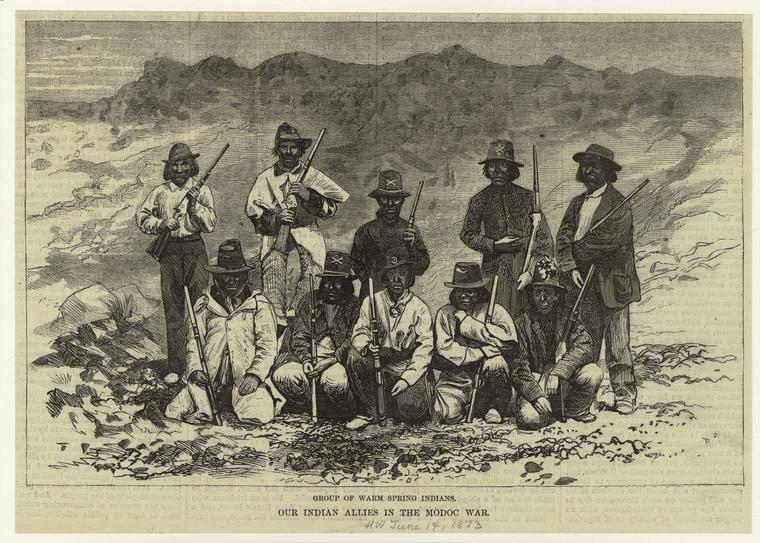 Eadweard Muybridge photographed the early part of the campaign.
Eadweard Muybridge photographed the early part of the campaign.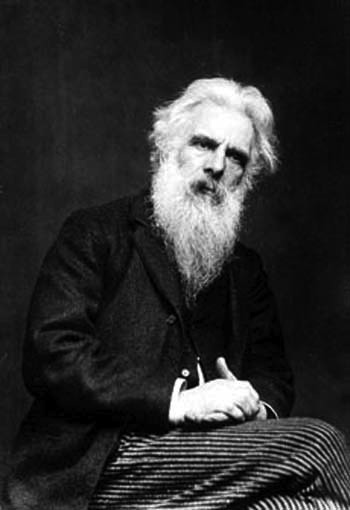
Captain Jack led 52 warriors in a band of more than 150 Modoc people who left the Klamath ![Donald McKy [McKay], the celebrated Warm Spring Indian Scout and his chief men.](http://images.nypl.org/index.php?id=G91F396_014F&t=w) Reservation. Occupying defensive positions throughout the lava beds south of Tule Lake,
Reservation. Occupying defensive positions throughout the lava beds south of Tule Lake, for months those few warriors successfully waged a guerrilla war against hundreds of United
for months those few warriors successfully waged a guerrilla war against hundreds of United  States Army forces sent
States Army forces sent  against them and reinforced with artillery. In April 1873, Captain Jack and others killed General Edward Canby
against them and reinforced with artillery. In April 1873, Captain Jack and others killed General Edward Canby and another peace commissioner, and wounded others.
and another peace commissioner, and wounded others.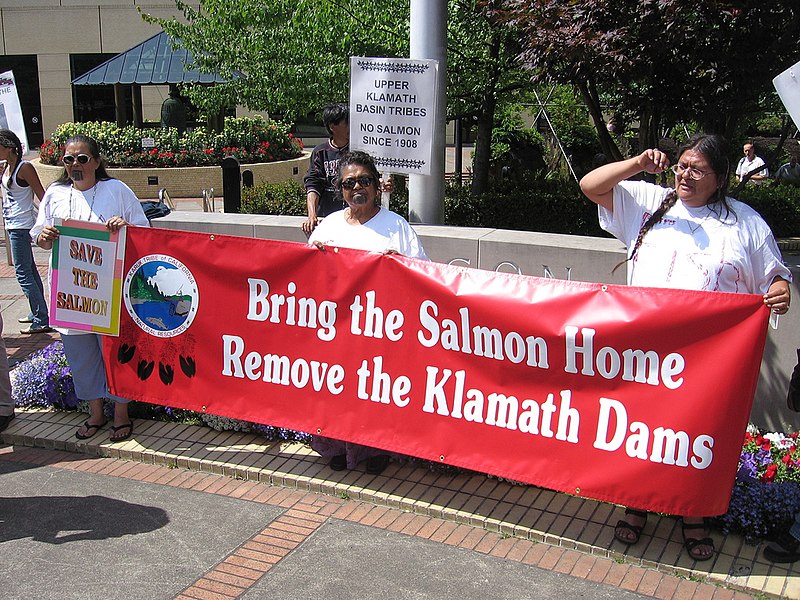


After more warfare with reinforcements of US forces, finally some Modoc warriors  surrendered, and Captain Jack and the last of his band were captured. Jack and five warriors
surrendered, and Captain Jack and the last of his band were captured. Jack and five warriors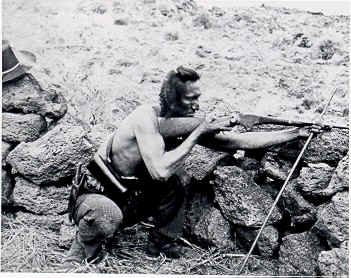 several leaders were tried for the murder of two peace commissioners; Jack and three
several leaders were tried for the murder of two peace commissioners; Jack and three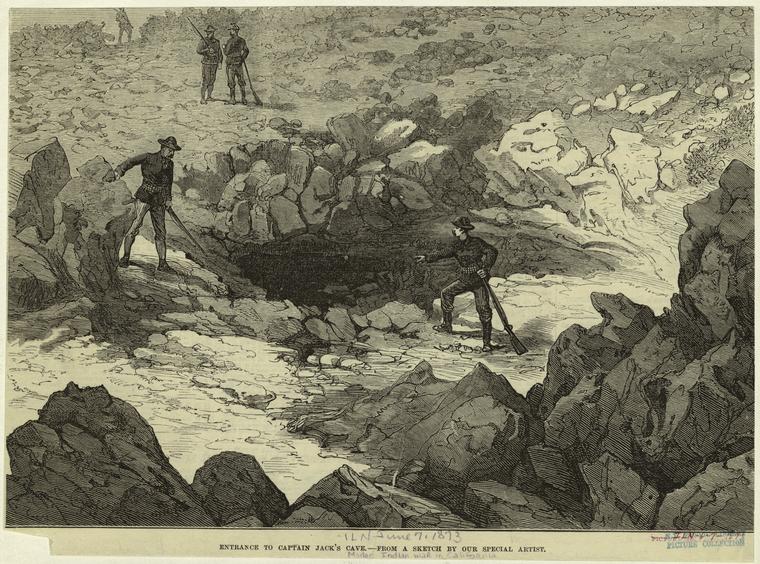 warriors were executed and two others sentenced for life imprisonment. The remaining 153 Modoc of the band were sent toIndian Territory, where they were held as prisoners of war
warriors were executed and two others sentenced for life imprisonment. The remaining 153 Modoc of the band were sent toIndian Territory, where they were held as prisoners of war 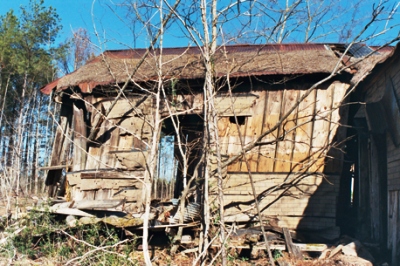 until 1909. Some at that point returned to the Klamath Reservation, but most (and their
until 1909. Some at that point returned to the Klamath Reservation, but most (and their 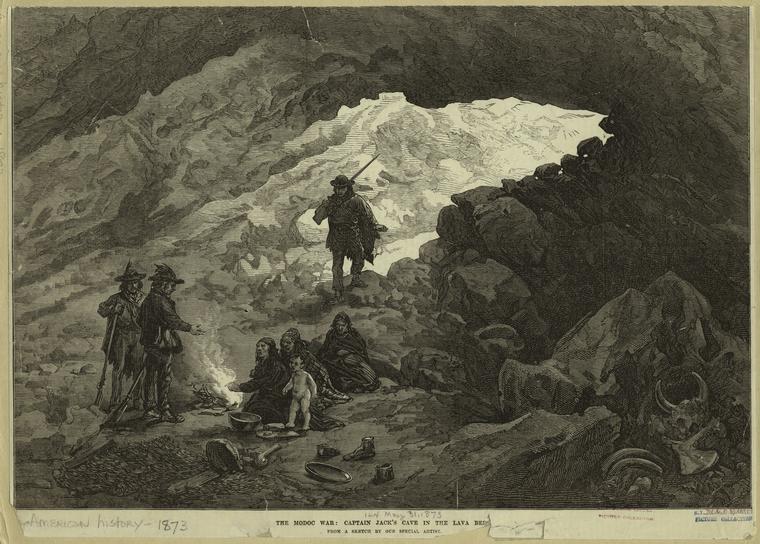 descendants) stayed in what was then the state of Oklahoma. As a result, there are federally recognized Modoc tribes in Oregon and Oklahoma today.
descendants) stayed in what was then the state of Oklahoma. As a result, there are federally recognized Modoc tribes in Oregon and Oklahoma today. The specific events go back to 1852. Although the Modoc initially had no trouble with European Americans, after
The specific events go back to 1852. Although the Modoc initially had no trouble with European Americans, after 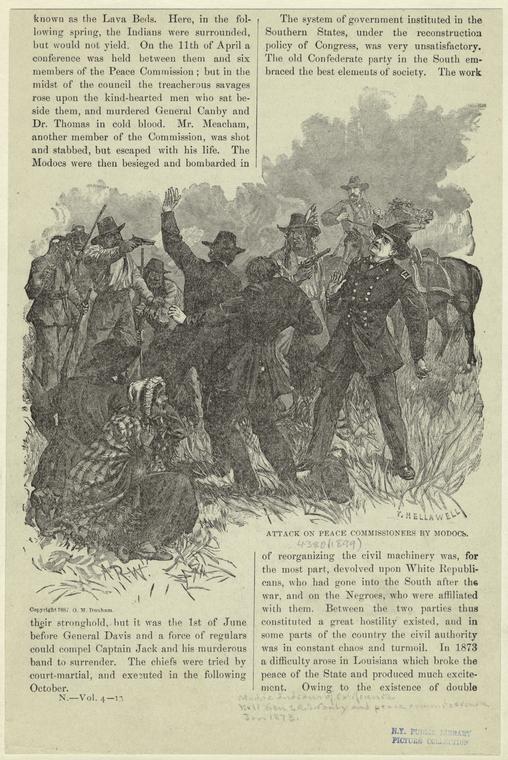 the murders of settlers in a raid by the Pit River Tribe, European-American militia, not familiar with the Indian (the California Volunteer
the murders of settlers in a raid by the Pit River Tribe, European-American militia, not familiar with the Indian (the California Volunteer  Militia was in fact nothing more than an armed mob.)
Militia was in fact nothing more than an armed mob.) peoples, in revenge attacked an innocent Modoc village, killing men, women and children. (Kintpuash, the future ((th
peoples, in revenge attacked an innocent Modoc village, killing men, women and children. (Kintpuash, the future ((th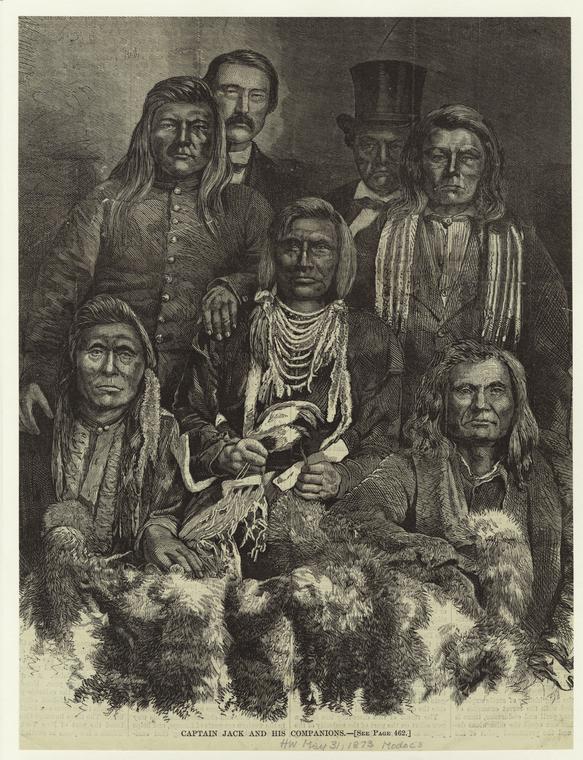 eer Militia was in fact nothing more than an armed mob.)chief also known as Captain Jack, survived the attack
eer Militia was in fact nothing more than an armed mob.)chief also known as Captain Jack, survived the attack  but lost some of his family.)
but lost some of his family.) In retaliation and to try to end European-American encroachment, some Modoc chose to attack the next whites they
In retaliation and to try to end European-American encroachment, some Modoc chose to attack the next whites they came across; they killed 65 white emigrants in a wagon train at what became known as Bloody Point.In another round of retaliation,
came across; they killed 65 white emigrants in a wagon train at what became known as Bloody Point.In another round of retaliation, California militia led by Ben Wright killed 41 Modoc at a peace parley.
California militia led by Ben Wright killed 41 Modoc at a peace parley.
Rounds of hostilities continued in the area until 1864, with warriors of the Klamath and the Yahooskin, a band of 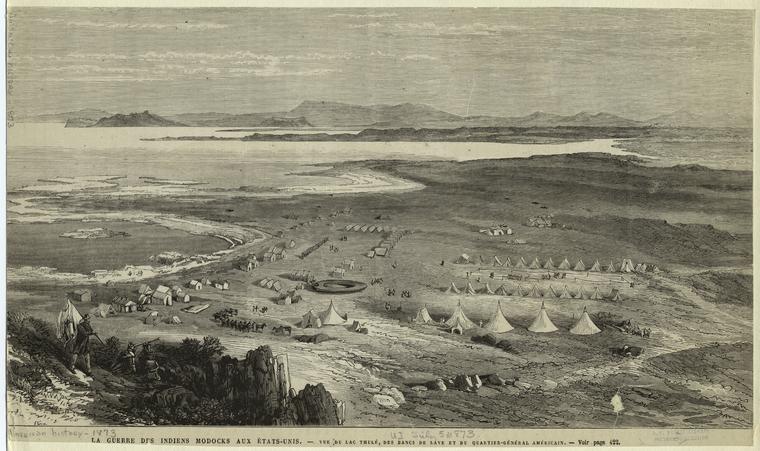 Shoshone, also attacking settlers and migrants in their turns. The United States and the Klamath, Modoc, and
Shoshone, also attacking settlers and migrants in their turns. The United States and the Klamath, Modoc, and  Shoshone (Yahooskin band) tribes signed a treaty, by which the Indians ceded millions of acres of lands and the
Shoshone (Yahooskin band) tribes signed a treaty, by which the Indians ceded millions of acres of lands and the US established the Klamath Reservation, within the boundaries of present-day Oregon.
US established the Klamath Reservation, within the boundaries of present-day Oregon.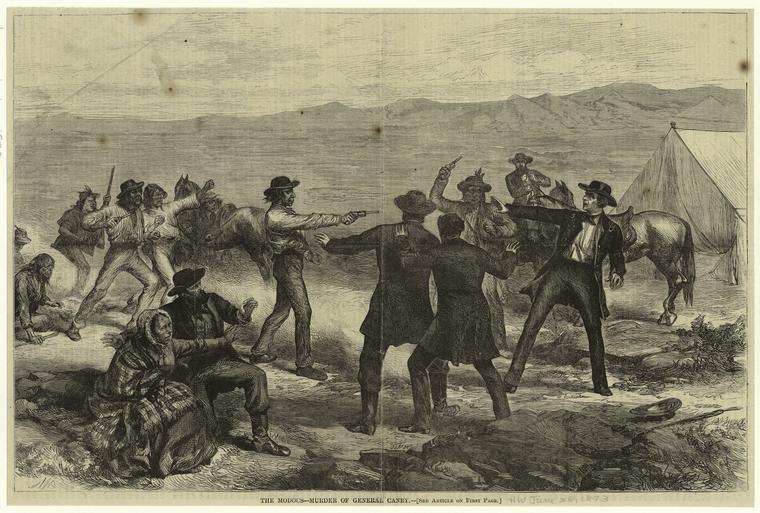 Under the treaty terms, the Modoc, with Old Chief Schonchin as their leader, gave up their lands in the Lost River,
Under the treaty terms, the Modoc, with Old Chief Schonchin as their leader, gave up their lands in the Lost River, Tule Lakeand Lower Klamath Lake regions of California, and moved to a reservation in the Upper Klamath River Valley.
Tule Lakeand Lower Klamath Lake regions of California, and moved to a reservation in the Upper Klamath River Valley.
Reluctant to leave their territory, the Modoc finally relocated in 1869 following a council between Captain Jack (also known as Kintpuash), a Modoc leader; Alfred B. Meacham, US Superintendent of Indian Affairs for Oregon;  O.C. Knapp, US Indian agent on the reservation; Ivan D. Applegate, sub-agent at Yainax on the reservation; and W.C. McKay. Meacham was from Oregon, and knew Captain Jack and the Modoc. When soldiers suddenly
O.C. Knapp, US Indian agent on the reservation; Ivan D. Applegate, sub-agent at Yainax on the reservation; and W.C. McKay. Meacham was from Oregon, and knew Captain Jack and the Modoc. When soldiers suddenly  appeared at the meeting, the Modoc warriors fled, leaving behind their women and children. Meacham placed the women and children in wagons and started for the reservation. He allowed "Queen Mary"
appeared at the meeting, the Modoc warriors fled, leaving behind their women and children. Meacham placed the women and children in wagons and started for the reservation. He allowed "Queen Mary" , Captain Jack's sister, to go meet with Captain Jack to persuade him to move to the reservation. She succeeded. Once on the reservation,
, Captain Jack's sister, to go meet with Captain Jack to persuade him to move to the reservation. She succeeded. Once on the reservation, Captain Jack and his band prepared to make their permanent home at Modoc Point.
Captain Jack and his band prepared to make their permanent home at Modoc Point.
 The Second Battle of Memphis was a battle of the American Civil War occurring on August 21, 1864, in Shelby
The Second Battle of Memphis was a battle of the American Civil War occurring on August 21, 1864, in Shelby  County, Tennessee. At 4:00 a.m. on August 21, 1864, Maj. Gen. Nathan Bedford Forrest
County, Tennessee. At 4:00 a.m. on August 21, 1864, Maj. Gen. Nathan Bedford Forrest  made a daring raid on Union-held Memphis, Tennessee, but it was not an attempt to capture the city, which was occupied by 6,000 Federal troops.
made a daring raid on Union-held Memphis, Tennessee, but it was not an attempt to capture the city, which was occupied by 6,000 Federal troops. The raid had three objectives: to capture three Union generals posted there; to release Southern prisoners from
The raid had three objectives: to capture three Union generals posted there; to release Southern prisoners from  Irving Block Prison; and to cause the recall of Union forces from Northern Mississippi. Striking northwestward for
Irving Block Prison; and to cause the recall of Union forces from Northern Mississippi. Striking northwestward for  Memphis with 2,000 cavalry, Forrest lost about a quarter of his strength because of exhausted horses. Surprise
Memphis with 2,000 cavalry, Forrest lost about a quarter of his strength because of exhausted horses. Surprise was essential. Taking advantage of a thick dawn fog and claiming to be a Union patrol returning with prisoners, the
was essential. Taking advantage of a thick dawn fog and claiming to be a Union patrol returning with prisoners, the
 missions. One union general was not at his quarters. Another, General Cadwallader C. Washburn escaped to Fort Pickering dressed in his night-shirt.
missions. One union general was not at his quarters. Another, General Cadwallader C. Washburn escaped to Fort Pickering dressed in his night-shirt. Forrest took Washburn's uniform, but later returned it under a flag of truce.According to Memphis legend, Confederate cavalrymen rode into
Forrest took Washburn's uniform, but later returned it under a flag of truce.According to Memphis legend, Confederate cavalrymen rode into
 the lobby of the luxurious
the lobby of the luxurious  Gayoso House Hotel seeking the Yankee officers. A street in Memphis is named "General Washburn's Escape
Gayoso House Hotel seeking the Yankee officers. A street in Memphis is named "General Washburn's Escape  Alley" in commemoration of the ordeal.The attack on Irving Block Prison also failed when Union troops stalled the main body at the State
Alley" in commemoration of the ordeal.The attack on Irving Block Prison also failed when Union troops stalled the main body at the State  Female College. After two hours, Forrest decided to withdraw, cutting telegraph wires, taking 500 prisoners and large quantities of supplies, including many horses.
Female College. After two hours, Forrest decided to withdraw, cutting telegraph wires, taking 500 prisoners and large quantities of supplies, including many horses.
 missions. One union general was not at his quarters. Another, General Cadwallader C. Washburn escaped to Fort Pickering dressed in his night-shirt.
missions. One union general was not at his quarters. Another, General Cadwallader C. Washburn escaped to Fort Pickering dressed in his night-shirt. Forrest took Washburn's uniform, but later returned it under a flag of truce.According to Memphis legend, Confederate cavalrymen rode into
Forrest took Washburn's uniform, but later returned it under a flag of truce.According to Memphis legend, Confederate cavalrymen rode into the lobby of the luxurious
the lobby of the luxurious  Alley" in commemoration of the ordeal.The attack on Irving Block Prison also failed when Union troops stalled the main body at the State
Alley" in commemoration of the ordeal.The attack on Irving Block Prison also failed when Union troops stalled the main body at the State  Female College. After two hours, Forrest decided to withdraw, cutting telegraph wires, taking 500 prisoners and large quantities of supplies, including many horses.
Female College. After two hours, Forrest decided to withdraw, cutting telegraph wires, taking 500 prisoners and large quantities of supplies, including many horses.
 provide protection. Union General Hurlbut was quoted afterward as saying, "There it goes again! They superseded me with Washburn
provide protection. Union General Hurlbut was quoted afterward as saying, "There it goes again! They superseded me with Washburn  because I could not keep Forrest out of West Tennessee, and Washburn cannot keep him out of his own bedroom!"
because I could not keep Forrest out of West Tennessee, and Washburn cannot keep him out of his own bedroom!"
 provide protection. Union General Hurlbut was quoted afterward as saying, "There it goes again! They superseded me with Washburn
provide protection. Union General Hurlbut was quoted afterward as saying, "There it goes again! They superseded me with Washburn 
 theres not much difference between them and ordinary indians except that they tended to wear hats usually
theres not much difference between them and ordinary indians except that they tended to wear hats usually captured from the army.
captured from the army.



![Donald McKy [McKay], the celebrated Warm Spring Indian Scout and his chief men.](http://images.nypl.org/index.php?id=G91F396_014F&t=w)














 Militia
Militia
 eer Militia
eer Militia




 Shoshone, also attacking settlers and migrants in their turns. The United States and the Klamath, Modoc, and
Shoshone, also attacking settlers and migrants in their turns. The United States and the Klamath, Modoc, and  Shoshone (Yahooskin band) tribes signed a treaty, by which the Indians ceded millions of acres of lands and the
Shoshone (Yahooskin band) tribes signed a treaty, by which the Indians ceded millions of acres of lands and the US established the Klamath Reservation, within the boundaries of present-day Oregon.
US established the Klamath Reservation, within the boundaries of present-day Oregon. Under the treaty terms, the Modoc, with Old Chief Schonchin as their leader, gave up their lands in the Lost River,
Under the treaty terms, the Modoc, with Old Chief Schonchin as their leader, gave up their lands in the Lost River, Tule Lakeand Lower Klamath Lake regions of California, and moved to a reservation in the Upper Klamath River Valley.
Tule Lakeand Lower Klamath Lake regions of California, and moved to a reservation in the Upper Klamath River Valley.

 appeared at the meeting, the Modoc warriors fled, leaving behind their women and children. Meacham placed the women and children in wagons and started for the reservation. He allowed "Queen Mary"
appeared at the meeting, the Modoc warriors fled, leaving behind their women and children. Meacham placed the women and children in wagons and started for the reservation. He allowed "Queen Mary" , Captain Jack's sister, to go meet with Captain Jack to persuade him to move to the reservation. She succeeded. Once on the reservation,
, Captain Jack's sister, to go meet with Captain Jack to persuade him to move to the reservation. She succeeded. Once on the reservation, Captain Jack and his band prepared to make their permanent home at Modoc Point.
Captain Jack and his band prepared to make their permanent home at Modoc Point.